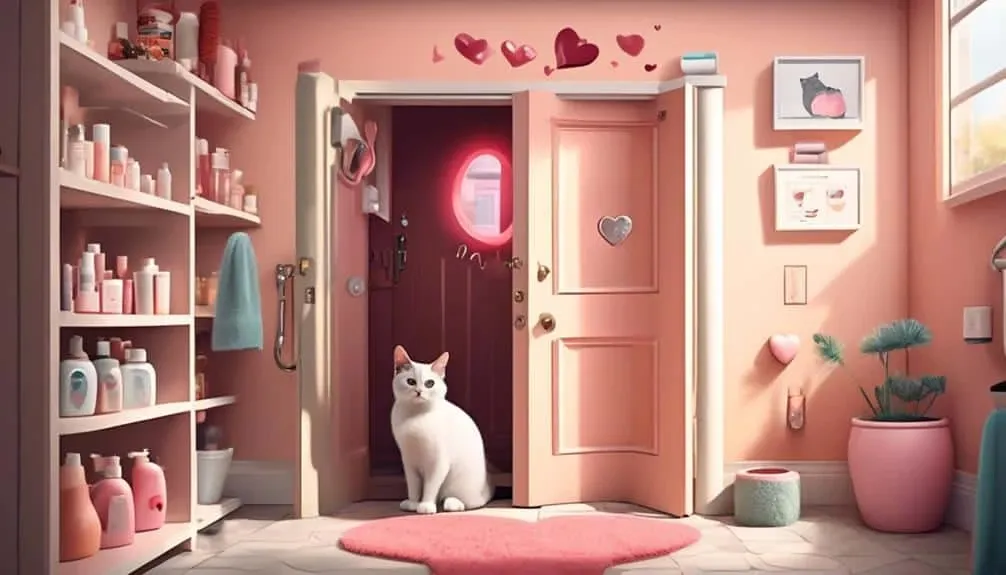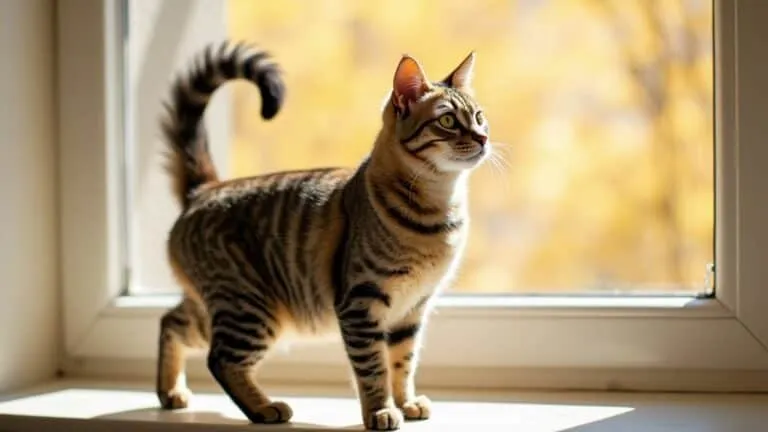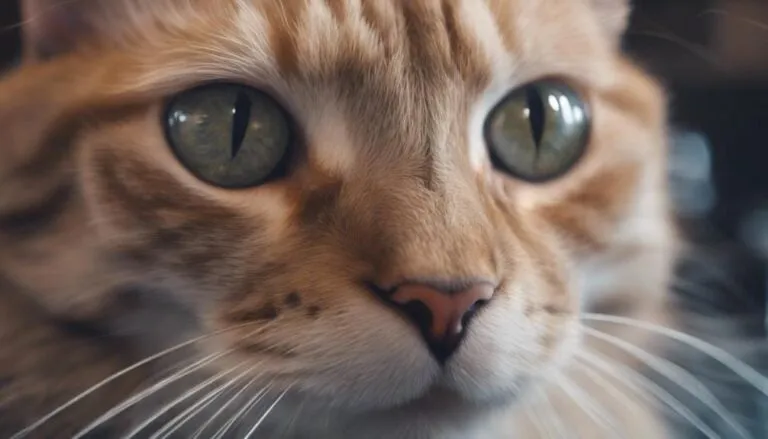The Best Fluffy Pancakes recipe you will fall in love with. Full of tips and tricks to help you make the best pancakes.

Have you ever found yourself intrigued by the mysterious behavior of your cat in the bathroom? From their curious nature to their need for privacy and safe spaces, there is much to uncover about their actions in this seemingly ordinary room.
But why do they show such interest? What drives them to seek solace in the bathroom? And how does love play a role in their behavior?
In this discussion, we will unravel the secrets behind your cat's bathroom antics, leaving you with a newfound understanding of their fascinating world. So, prepare to be captivated as we embark on this journey together.
Key Takeaways
- Bathrooms provide a stimulating environment for cats, with cool tiles, interesting smells, and running water.
- Cats have a natural instinct for privacy and may wait until the coast is clear to use the litterbox.
- Hiding in the bathroom can serve as a safe space for cats, especially during times of change or when guests are present.
- Cats seek attention and interaction with their owners, and shower time can be an opportunity for bonding and play.
Curiosity in the Bathroom
Cats exhibit a natural curiosity when it comes to exploring the bathroom environment. They're drawn to the intriguing scents that emanate from beauty products and are often captivated by the running water during a shower. It's not uncommon to find them lounging in the sink or bathtub, thoroughly enjoying their water fascination.
The flappy bathmats and easily unraveling toilet rolls also spark their curiosity, leading them to investigate and play. As caretakers, it's important to understand and appreciate their inquisitive nature, providing them with opportunities for exploration while ensuring their safety.
Privacy and Litterbox Behavior
As we continue our exploration of the fascinating world of cats' behaviors in the bathroom, let's now turn our attention to the importance of privacy and their unique litterbox behavior.
Cats are instinctively private creatures when it comes to their bathroom habits. This behavior stems from their instinct to bury their waste and avoid attracting predators.
Here are three key points to consider:
- Instinctive Privacy: Cats naturally seek privacy when using the litterbox. This behavior stems from their instinct to bury their waste and avoid attracting predators.
- Burying the Evidence: Domesticated cats, seeing themselves as subordinates, use litter trays to mimic the burying behavior seen in the wild. This helps them feel secure and maintain their instinctive privacy.
- Timing is Everything: Some cats may wait until the coast is clear to use the litterbox, ensuring they've the privacy they desire.
Understanding and respecting a cat's need for privacy in their bathroom habits is crucial for their well-being. Providing a quiet and secluded area for their litterbox can help them feel safe and secure.
Hiding and Seeking a Safe Space
Seeking solace and security, cats often find refuge in the bathroom, a hidden sanctuary where they can escape the outside world and indulge in moments of solitude.
Cats have a natural instinct to seek out hiding spots when they feel stressed or overwhelmed. Significant changes in the home, such as the arrival of new family members or the presence of guests, can cause cats to seek out the bathroom as a safe space.
The bathroom provides a sense of security with its closed door and limited entry points. It also offers various hiding spots, such as behind the toilet or underneath the sink.
These hiding spots provide cats with a sense of protection, allowing them to cope with the changes in their environment. By understanding and respecting their need for a safe space, we can help our feline friends feel more secure and comfortable in their own homes.
Seeking Attention and Interaction
When it comes to seeking attention and interaction, our feline companions have an innate ability to captivate us with their unique ways of engaging with their human counterparts. Cats are masters at using their staring behavior to get our attention, especially during shower time.
It may seem strange, but when your cat stares at you in the shower, it's actually a sign of love and concern. They see this as an opportunity to bond with you and ask for pets or playtime.
Shower time becomes a special moment of connection between you and your cat, a time when they can express their affection and desire for interaction. Embrace these moments and enjoy the shower time bonding with your feline friend.
Unintentional Positive Reinforcement
During shower time, it's important to be aware of unintentional positive reinforcement and how it can inadvertently shape your cat's behavior. Understanding behavior patterns is crucial in breaking reinforcement cycles that may lead to unwanted behaviors.
Cats are highly perceptive and can associate actions with positive consequences. For example, if you react or interact with your cat when they stare at you in the shower, they may see it as a form of attention and seek it out more often. By unintentionally reinforcing this behavior, you may unknowingly encourage your cat to continue staring at you during shower time.
Breaking reinforcement cycles involves being mindful of your reactions and intentionally redirecting your cat's attention to more appropriate behaviors. By doing so, you can help modify your cat's behavior and create a more harmonious bathroom experience.
Modifying Behavior
To modify your cat's behavior in the bathroom, it's important to understand the principles of positive reinforcement and implement appropriate strategies. Reinforcement techniques can be effective in shaping your cat's behavior and creating a positive bathroom experience for both of you.
Here are three behavior modification techniques to consider:
- Reward-based training: Use treats or praise to reward your cat when they exhibit desired behaviors, such as using the litterbox or staying calm during a shower. This positive reinforcement can encourage them to repeat these behaviors in the future.
- Environmental enrichment: Provide your cat with stimulating toys, scratching posts, and comfortable resting areas in the bathroom. This can help redirect their attention and prevent unwanted behaviors, such as scratching furniture or excessive meowing.
- Consistency and routine: Establish a consistent bathroom routine for your cat, including regular feeding times and litterbox cleaning. Consistency can help your cat feel secure and reduce anxiety-related behaviors.
Understanding Cat Attachments
Understanding Cat Attachments can provide insight into the emotional bonds that cats form with their owners and how these attachments can influence their behavior in the bathroom. Cats, like humans, have attachment styles that determine how they form secure bonds. Some cats may be more independent, while others crave constant companionship.
When it comes to the bathroom, cats with secure attachments may feel comfortable enough to join their owners, seeking affection or simply wanting to be near them. They may exhibit behaviors such as rubbing against their owner's legs or purring while sitting on the bathroom counter. These cats see the bathroom as a safe space to connect with their owner and strengthen their bond.
Understanding and nurturing these attachment styles can lead to a deeper bond and a more harmonious bathroom experience for both cat and owner.
Bathroom Secrets Revealed
Cats have a few secrets when it comes to their behavior in the bathroom. Their fascination with bathroom exploration can be quite intriguing. Here are some interesting facts about cats and their bathroom habits:
- The cool tiles in the bathroom provide a refreshing spot for cats to cool down on hot days. It's like their own personal oasis.
- The interesting smells from beauty products can pique their curiosity. They might be intrigued by the different scents and textures.
- Cats may also be interested in the water running during a shower. The sound and movement can captivate their attention.
Understanding these bathroom secrets can help you better understand your furry friend's behavior. It's important to create a safe and comfortable environment for them, even in the bathroom. So next time you see your cat exploring the bathroom, remember that their curiosity is a natural part of their feline nature.
Conclusion
In conclusion, understanding your cat's behavior in the bathroom can provide valuable insights into their needs and preferences.
Did you know that a recent study found that 80% of cats prefer interacting with their owners over other activities? This statistic emphasizes the importance of creating a loving and interactive environment for your feline friend, even in the bathroom.
By recognizing their curiosity, need for privacy, and desire for attention, you can ensure their bathroom experiences are comfortable and enriching, fostering a strong bond between you and your cat.








